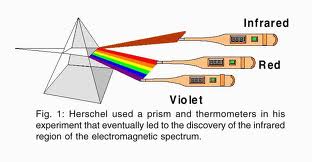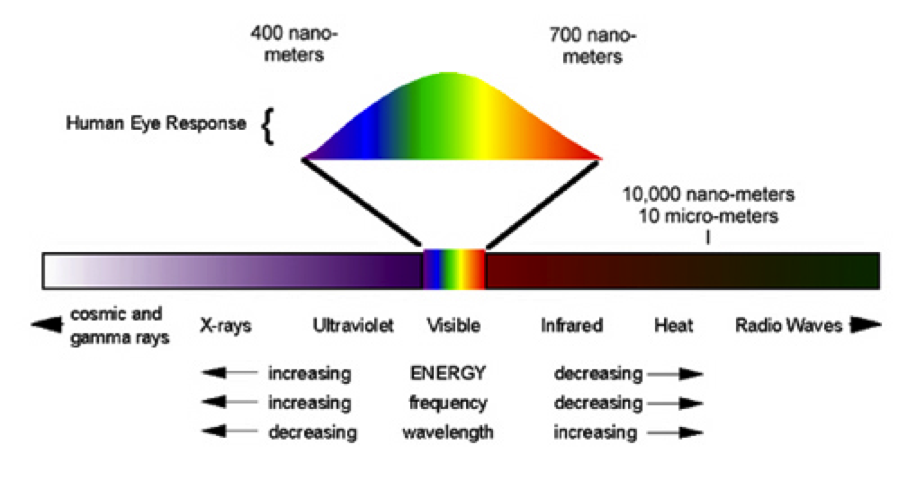Infrared
The Science Behind Infrared Sensors
Tour of The Electromagnetic Spectrum
http://missionscience.nasa.gov/ems/index.html
INFRARED ENERGY
A remote control uses light waves just beyond the visible spectrum of light—infrared light waves—to change channels on your TV. This region of the spectrum is divided into near-, mid-, and far-infrared. The region from 8 to 15 microns (µm) is referred to by Earth scientists as thermal infrared since these wavelengths are best for studying the long wave thermal energy radiating from our planet.
| a television remote control |
A typical television remote control uses infrared energy at a wavelength around 940 nanometers.
http://missionscience.nasa.gov/ems/07_infraredwaves.html
http://science.hq.nasa.gov/kids/imagers/ems/infrared.html
What is Infrared?
Our eyes are detectors which are designed to detect visible light waves (or visible radiation). Visible light is one of the few types of radiation that can penetrate our atmosphere and be detected on the Earth's surface. There are forms of light (or radiation) which we cannot see. Actually we can only see a very small part of the entire range of radiation called the electromagnetic spectrum .
external image em3.jpg The electromagnetic spectrum includes gamma rays, X-rays, ultraviolet, visible, infrared, microwaves, and radio waves. The only difference between these different types of radiation is their wavelength or frequency. Wavelength increases and frequency (as well as energy and temperature) decreases from gamma rays to radio waves. All of these forms of radiation travel at the speed of light (186,000 miles or 300,000,000 meters per second in a vacuum). In addition to visible light, radio, some infrared and a very small amount of ultraviolet radiation also reaches the Earth's surface from space. Fortunately for us, our atmosphere blocks out the rest, much of which is very hazardous, if not deadly, for life on Earth.
http://coolcosmos.ipac.caltech.edu/cosmic_classroom/ir_tutorial/what_is_ir.html
The discovery of Infrared

In 1800, a scientist named Sir Frederick William Herschel directed sunlight through a glass prism to create a spectrum - the "rainbow" created when light is divided into its colors - and measured the temperature of each color. He used three thermometers with blackened bulbs (to better absorb the heat) and placed one bulb in each color while the other two were placed beyond the spectrum as control samples.
As he measured the temperatures of the violet, blue, green, yellow, orange and red light, he noticed that all of the colors had temperatures higher than the controls and that the  temperature of the colors increased from the violet to the red part of the spectrum. After noticing this pattern, Herschel decided to measure the temperature just beyond the red portion of the spectrum in a region apparently devoid of sunlight. To his surprise, he found that this region had the highest temperature of all.
temperature of the colors increased from the violet to the red part of the spectrum. After noticing this pattern, Herschel decided to measure the temperature just beyond the red portion of the spectrum in a region apparently devoid of sunlight. To his surprise, he found that this region had the highest temperature of all.
Herschel performed further experiments on what he called the "calorific rays" that existed beyond the red part of the spectrum and found that they were reflected, refracted, absorbed and transmitted just like visible light. What Sir William had discovered was a form of light (or radiation) beyond red light. These "calorific rays" were later renamed infrared rays or infrared radiation (the prefix infra means `below'). Herschel's experiment was important not only because it led to the discovery of infrared, but also because it was the first time that someone showed that there were forms of light that we cannot see with our eyes.
http://coolcosmos.ipac.caltech.edu/cosmic_classroom/ir_tutorial/discovery.html
Infrared light shows us the heat radiated by the world around us. By viewing animals with a thermal infrared camera, we can actually "see" the differences between warm and cold-blooded animals. Infrared also allows us to study how well feathers, fur and blubber insulate animals. As you tour this "Infrared Zoo", see what new information you can gather about the animals here that you would not get from a visible light picture.
Infrared Zoo from CalTech
http://coolcosmos.ipac.caltech.edu/image_galleries/ir_zoo/
NASA
http://missionscience.nasa.gov/ems/07_infraredwaves.html
Tour of the Electromagnetic Spectrum
http://missionscience.nasa.gov/ems/index.html

http://9-4fordham.wikispaces.com/Electro+Magnetic+Spectrum+and+light
Seeing Infrared Light
http://www.lpi.usra.edu/education/fieldtrips/2005/activities/ir_spectrum/
Classroom Demo
Purpose. You and your students will ‘see' infrared light, normally invisible to the human eye, as a continuation of the visible rainbow spectrum.
Introduction. The existence of infrared or invisible light is difficult to demonstrate convincingly. We use invisible light (electromagnetic radiation) all over – TV/VCR remote controls, wireless computer connections, radio and TV transmissions, microwaves for communications and cooking. Our eyes can detect only a small part of this electromagnetic spectrum.


http://www.google.com/imgres?imgurl=http%3A%2F%2Fwww.liparanormalinvestigators.com%2Fimages%2Farticles%2Fem_spectrum.gif&imgrefurl=http%3A%2F%2Fwww.liparanormalinvestigators.com%2Flight.shtml&h=318&w=670&tbnid=-DND_5nLFhI1FM%3A&zoom=1&docid=eodqE_HqMpXS6M&ei=6TBlU6TTGc-GyASj74GgCw&tbm=isch&ved=0CI8BEDMoMjAy&iact=rc&uact=3&dur=3687&page=3&start=35&ndsp=18
How An IR Sensor Works
IR Sensors work by using a specific light sensor to detect a select light wavelength in the Infra-Red (IR) spectrum. By using an LED which produces light at the same wavelength as what the sensor is looking for, you can look at the intensity of the received light. When an object is close to the sensor, the light from the LED bounces off the object and into the light sensor. This results in a large jump in the intensity, which we already know can be detected using a threshold.
Detecting Brightness
Since the sensor works by looking for reflected light, it is possible to have a sensor that can return the value of the reflected light. This type of sensor can then be used to measure how "bright" the object is. This is useful for tasks like line tracking.
Carnegie Mellon Robotics Academy
http://www.education.rec.ri.cmu.edu/content/electronics/boe/ir_sensor/1.html
Working Principle and Application
Types of Infra-Red Sensors
Infra-red sensors are broadly classified into two types:
- Thermal infrared sensors – These use infrared energy as heat. Their photo sensitivity is independent of wavelength. Thermal detectors do not require cooling; however, they have slow response times and low detection capability.
- Quantum infrared sensors – These provide higher detection performance and faster response speed. Their photo sensitivity is dependent on wavelength. Quantum detectors have to be cooled so as to obtain accurate measurements. The only exception is for detectors that are used in the near infrared region.
Working Principle
A typical system for detecting infrared radiation using infrared sensors includes the infrared source such as blackbody radiators, tungsten lamps, and silicon carbide. In case of active IR sensors, the sources are infrared lasers and LEDs of specific IR wavelengths. Next is the transmission medium used for infrared transmission, which includes vacuum, the atmosphere, and optical fibers.
Thirdly, optical components such as optical lenses made from quartz, CaF2, Ge and Si, polyethylene Fresnel lenses, and Al or Au mirrors, are used to converge or focus infrared radiation. Likewise, to limit spectral response, band-pass filters are ideal.
Finally, the infrared detector completes the system for detecting infrared radiation. The output from the detector is usually very small, and hence pre-amplifiers coupled with circuitry are added to further process the received signals.
Applications
The following are the key application areas of infrared sensors:
- Tracking and art history
- Climatology, meteorology, and astronomy
- Thermography, communications, and alcohol testing
- Heating, hyperspectral imaging, and night vision
- Biological systems, photobiomodulation, and plant health
- Gas detectors/gas leak detection
- Water and steel analysis, flame detection
- Anesthesiology testing and spectroscopy
- Petroleum exploration and underground solution
- Rail safety.
http://www.azosensors.com/Article.aspx?ArticleID=339
Engineer's Garage
http://www.engineersgarage.com/articles/infrared-sensors
Wise Geek
http://www.wisegeek.org/what-is-an-infrared-sensor.htm
See For Yourself
- IR detectors (and emitters) can be found almost everywhere. If you have a computerexternal image icon1.png mouse with a red LED or laser--it is using IR light. Try using this mouse on a damp mouse pad--water almost completely absorbs the IR and the mouse won't work as well.
TVexternal image icon1.png and stereo remotes also use IR signals--the TV has an IR detector that interprets the signal from the remote. Most digital cameras are sensitive to IR light. Turn on your camera and point the TV remote at the camera. Press a button on the remote and you will see a pinkish or purplish light coming out of the remote on the LCD display of the camera. That is the IR signal from the remote.
Read more: http://www.ehow.com/how-does_5561845_do-ir-sensors-work.html#ixzz30lNkD1AN
IR Sensor Applications
http://www.infratec-infrared.com/applications.htm
How Stuff Works
http://home.howstuffworks.com/home-improvement/household-safety/security/question238.htm
Infrared vs. Ultrasonic
http://www.societyofrobots.com/member_tutorials/book/export/html/71
PIR Motion Sensor Tutorial
http://www.instructables.com/id/PIR-Motion-Sensor-Tutorial/
Characteristics and Uses of IR Detectors
http://roic.sabanciuniv.edu/pdf/infrared_detectors.pdf

